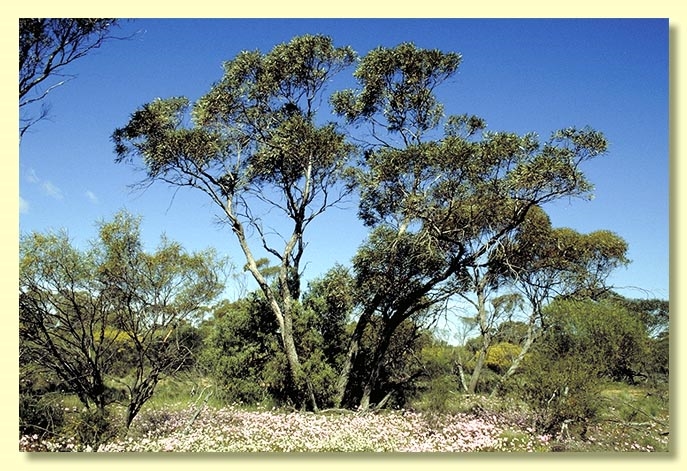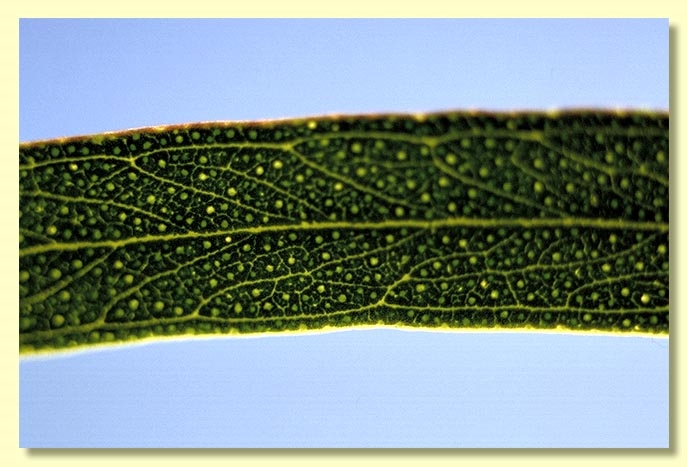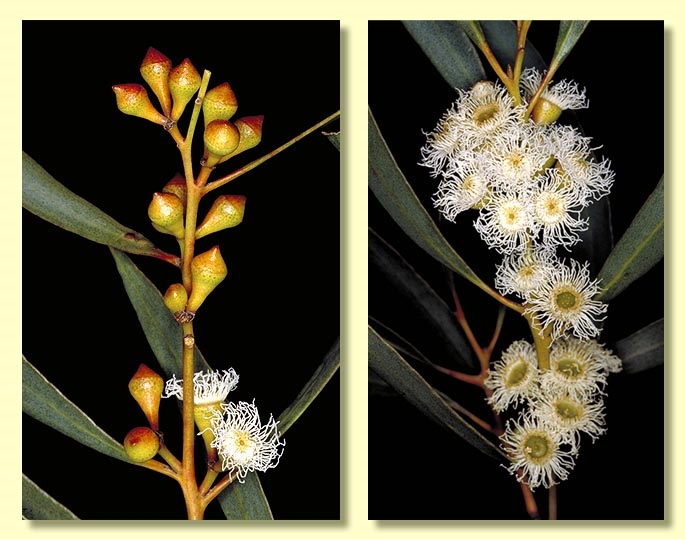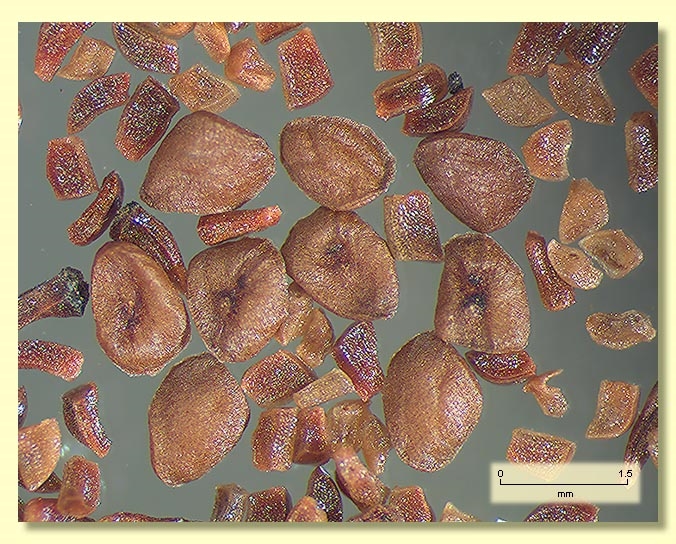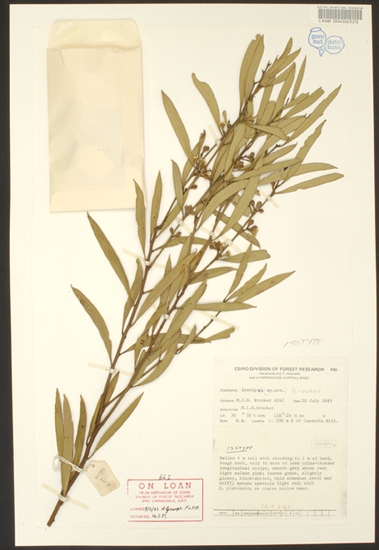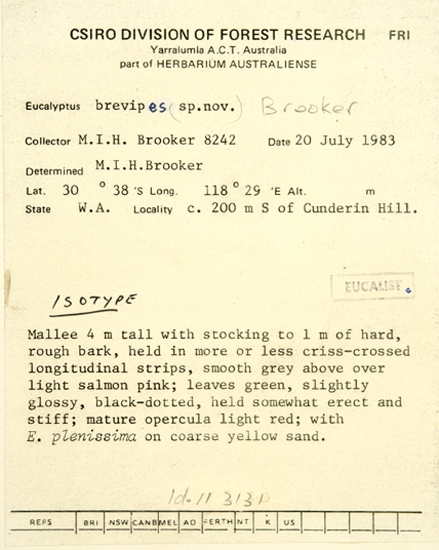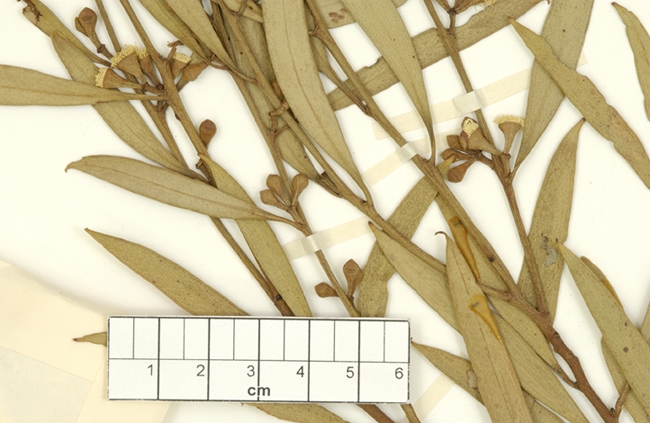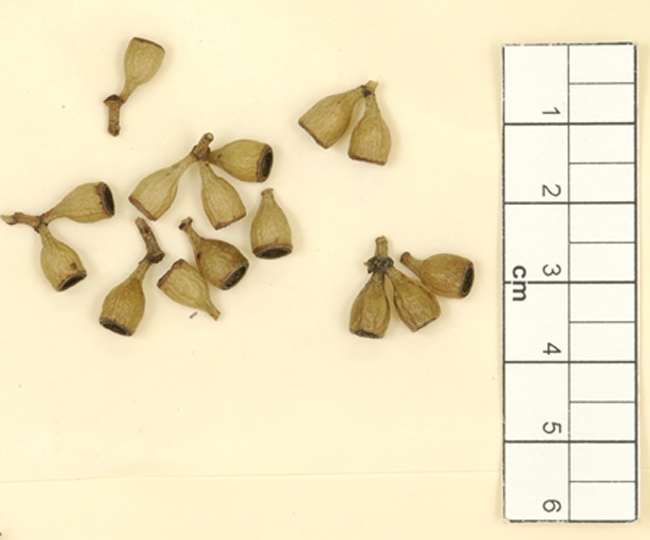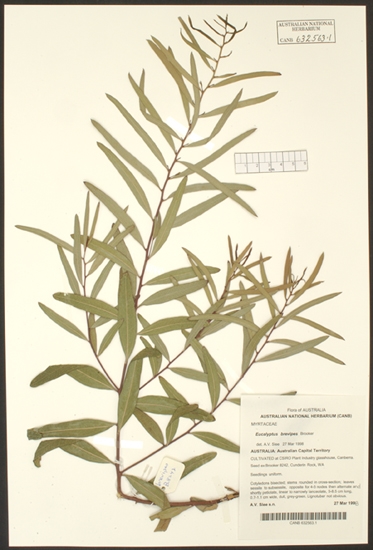Eucalyptus | Symphyomyrtus | Bisectae | Destitutae | Heterostemones
Euclid - Online edition
Eucalyptus brevipes
Bark firm, fibrous to coarsely flaky, rough over part or all of trunk and often extending to ca 5 cm diameter branches, smooth above grey and bronze to salmon-pink.
Branchlets lacking oil glands in the pith.
Juvenile growth (coppice or field seedlings to 50 cm): stems rounded in cross-section; juvenile leaves shortly to obscurely petiolate, alternate, linear to narrowly lanceolate, 5–8 cm long, 0.7–1.5 cm wide, dull, green.
Adult leaves held erect and more or less stiff, alternate, petioles 0.4–1 cm long; blade linear to narrowly elliptical or narrowly lanceolate, (6.3)7–12.5 cm long, 0.7–1 cm wide, base tapering to petiole, margin entire, apex finely pointed and sometimes hooked, side-veins very acute, reticulation usually sparse to moderate, intramarginal vein remote from margin, oil glands large, both round island and irregular intersectional.
Inflorescence axillary unbranched, peduncles 0.2–0.6 cm long, buds 7 per umbel, pedicels 0.2–0.4 cm long. Mature buds obovoid to pyriform ((0.4)0.7–0.8 cm long, 0.3–0.5 cm wide), scar present (outer operculum shed early), operculum conical or slightly beaked (0.2–0.3 cm long), outer staminodes (staminal filaments without anthers) ascending and then flexed tangentially, then inflexed, inner stamens inflexed and much shorter with the oblong-reniform to more or less spherical anthers scarcely versatile, sub-dorsifixed, dehiscing by subterminal pores, style long and straight, narrowed basally, stigma rounded, locules 3 or 4, the placentae each with 4 vertical rows of ovules. Flowers white.
Fruit pedicellate (pedicels 0.1–0.4 cm long), cylindrical to more or less barrel-shaped, 0.6–0.7 cm long, 0.4–0.7 cm wide, disc descending obliquely or vertically, valves 3 or 4, enclosed.
Seeds tan, 0.8–2 mm long, flattened-ovoid, dorsal surface smooth, hilum ventral.
Cultivated seedlings (measured at node 10): cotyledons Y-shaped (bisected); stems rounded in cross-section; leaves sessile to subsessile, opposite for 4 or 5 nodes then alternate and shortly petiolate, linear to narrowly lanceolate, 5–8.5 cm long, 0.7–1 cm wide, dull, grey-green.
Flowering has been recorded in July, August and September.
A mallee endemic to Western Australia, of very restricted distribution in the central wheatbelt between Mukinbudin, Cunderin Hill and Chiddarcooping Rock. The bark is rough and the adult leaves held stiffly erect, and at first slightly glossy maturing very glossy green.
Eucalyptus brevipes belongs in Eucalyptus subgenus Symphyomyrtus section Bisectae subsection Destitutae because buds have two opercula, cotyledons are Y-shaped and branchlets lack oil glands in the pith. Within this subsection E. brevipes is one of seven closely related species that form series Heterostemones. This series is characterised by the barren outer stamens that are conspicuously twisted and spreading in flower and the much shorter fertile inner stamens that are held erect. Species in this group also have narrow fruit with a descending disc and enclosed valves while the leaves have side-veins quite acute at the base of the lamina and usually sparse reticulation.
E. brevipes is distinguished from its closest relative E. gracilis by having bud clusters on a shorter peduncle, buds on short tapering pedicels and with conical to beaked opercula. Both these species have narrowly elliptical-lanceolate seedling and juvenile leaves. E. yilgarnensis, which is also closely related to E. brevipes and occurs in the same geographical area, differs in having slenderly pedicellate buds with rounded opercula, smaller fruit and elliptical to ovate-lanceolate juvenile leaves. Another related species is E. celastroides subsp. virella, which has buds that are square basally and have a conical operculum and urceolate fruit. E. celastroides subsp. celastroides differs further in having a grey-green to glaucous crown. The remaining species in series Heterostemones, E. calycogona, E. prolixa and E. quadrans, all have buds and fruit square in cross-section and should never be confused with E. brevipes.
Eucalyptus brevipes is listed as "Endangered" under the Australian Government Environment Protection and Biodiversity Conservation Act 1999 (EPBC Act). Further information may be found at this web address:
http://www.environment.gov.au/cgi-bin/sprat/public/sprat.pl

